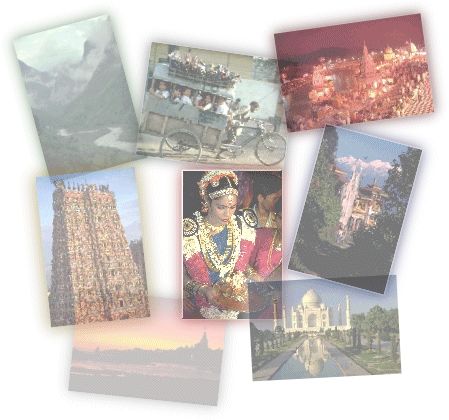 |
|
iMahal: I vividly remember my first trip to India. Being born and brought up in the US, it was quite a shock for me to be in such a different culture and world. As a young nine-year old, my only concern was how to get the bugs away from me! However, now when I go back as an adult I realize how much India has to offer, how the people, for the most part, do not live such a chaotic lifestyle as in the West.
iMahal: Let's pick up on Raja Yoga, which you had mentioned earlier. Could you tell us more about it?
Arnett: Raja Yoga is a composite of the best of the three main paths of yoga, plus meditation. The three main paths of yoga are devotion (Bhakti Yoga), service (Karma Yoga), and wisdom (Gyan Yoga). Since I do not have enough of any of those three qualities to succeed through following one path alone, I feel Raja Yoga is well suited for me.
Through the daily practice of Raja Yoga combined with Kriya Yoga meditation and living a life of dharma (right activity), I know that it is just a matter of time--"when" not "if"--for all of us!
iMahal: You have been practicing meditation and yoga for such a long time. Do you plan to teach meditation and/or yoga?
Arnett: In all the presentations I make, I do introduce meditation techniques as prescribed by Pantanjali to encourage people to practice them. But I don't have any plans to teach yoga or meditation. In fact, the teachings I follow state that until you can transport your consciousness out of the body and bring it back at will, you have no business teaching meditation. So until I master the self, I will leave teaching meditation to others who have.
iMahal: Can you please summarize, in a proverbial sentence, your mission vis-a-vis India?

iMahal: What other projects are you currently working on? Are we likely to hear a lot more about Robert Arnett and his love of India in next few years? Arnett: My goal for the book is to update the photography and stories. Currently I am also assembling a team to make a documentary film about India. The plan is to start shooting the film in January 2001 and to have it done by the end of the year. Due to advances in digital video technology, the project in this timeframe is viable. We forecast that our budget will be a tenth of what it would cost to work with a full film crew. The Dharma Foundation, which I am in the process of starting, will give us a non-profit framework to raise the necessary money. We are privately raising money for this movie. We hope to create a documentary film that can be aired on television. We want to make sure that people can see and learn about the eternal verities of India that most people have not seen. Some of the topics in the documentary will be dharma [literal translation is religion, but the term is also used in a broader sense as how religion reflects in our individual lives as "righteous action"] and bhakti [devotion]; these are the two major traditions in India. For this reason we feel that this movie can be successful both within and outside of India. I am very excited about this project because we will be showing the aspects of India that most travelers never see. We will try to show the completed documentary on as many North American television stations as we can. This will be a challenge. Just as no publisher would publish India Unveiled, I'm told that no television company or network station like PBS [Public Broadcast System - a publicly funded network in the US] would put up the money for this project. I have no past experience to show them. Heck I've never even taken a home video! Hopefully the final product will be something so beautiful that the networks will be pleased to show it. Although I will get some professional help, I hope to do some of the camera-work myself since I do have an aesthetic eye. Currently someone at Universal Studios in Los Angeles is consulting with me on doing this project. iMahal: Through your lectures, books and exhibits, what part of your mission have you already accomplished? What else do you hope to accomplish? Arnett: It is an on-going effort. I have been going to various cities to lecture about India. Right now I am doing a youth camp tour, and I talk with the children of Indian descent. I feel that children listen to me -- more than they do to their parents, or other Indians, or swamis -- because I am an outsider. When the kids see me, they are curious about how I, a non-Indian, can lecture to them about India. For this reason they are interested in what I have to say. Most of these kids go to India to see family and have not seen a lot of India. To them, I show an image of India that they don't know.
As you well know, it's very difficult for children to be raised bicultural. I experienced such a difficulty, growing up as a Jew in Columbus, Georgia. Having faced discrimination against Jews at that time, I can relate to the pressures the kids of Indian descent are going through. It's not an Indian thing but a cultural thing. I did not want to be thought of as Jew but as an American. Even today there is tremendous pressure for any ethnic group, outside of the white, Anglo-Saxon Christian mainstream, to conform. It is quite unnecessary to exert such pressure since no culture has the exclusive on truth.
Fortunately, my viewpoint is thought of as an objective viewpoint and not an Indian viewpoint. I have found that the only way to change the youth's negative thinking of India is to paint a very positive upbeat picture of India. Although some of them are taught Hindu scriptures and the religion, most have never really been exposed to the beautiful aspects of Indian culture. iMahal: A documentary, update of the book, lectures, seminars - that is a pretty ambitious schedule!
Last night I was at a youth camp where I was telling them that when I was in India in 1988 the Mahabharata [an Indian, spiritual epic presenting the conflict of the good and evil] had just been aired on television. On a trip to India ten years later in 1998, I saw in newspapers that it had the highest TV ratings ever in India. During my lecture, I asked the kids what had the highest ratings in the US. One of the kids pointed out -- and I am sure it is quite correct -- that it was "Who Wants to Be A Millionaire." I think this really points out the difference between the East and the West. Sure people in both cultures want material comforts to take care of their families and themselves, but the show here that has the highest ratings is based strictly on materialistic issues whereas the show in India with the highest ratings is a spiritual one based on scriptures.
|
 |
|
 |
|||||
